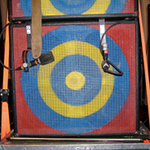Karen J. Leader: CAA Book Author Interview
This is the third in a series of short interviews with the authors of The Eye, the Hand, the Mind: 100 Years of the College Art Association, a book edited by Susan Ball and published in conjunction with CAA’s Centennial.
Karen J. Leader
A specialist in nineteenth-century art, Karen J. Leader is assistant professor of art history at Florida Atlantic University in Boca Raton. After receiving a BA from the University of California, Berkeley, she earned a PhD at New York University’s Institute of Fine Arts, studying under Linda Nochlin. Leader has published “Harlot, Housewife, or Heroine? A Recovered Identity for the ‘Worker’s Wife’ in Courbet’s Studio” in Rutgers Art Review and “Issues of Gender in Courbet’s Studio” in Courbet à neuf! (Paris: Éditions de la Maison des sciences de l’homme, 2010), from a symposium held at the Musée d’Orsay in Paris. Her current projects include “How to Look: Ad Reinhardt, PM, and the ‘Art-Politics Syndrome’” and “Connaisseuses and Cocottes: Women at the Salon in Nineteenth-Century French Caricature.”
From the Monuments Men to the invasion of Iraq, Leader traces the organization’s political work in her chapter, “CAA Advocacy: The Nexus of Art and Politics.” She chronicles CAA’s work in establishing standards for the provenance of cultural objects in the postwar era, striving to separate art from government propaganda in the 1950s, and then taking up arms in the Culture Wars of the late 1980s and early 1990s.
What was the most surprising thing that you learned about CAA during your research and writing?
I was truly surprised, and impressed, by how seriously CAA has taken its advocacy role in various periods throughout its history. As I recommend in my chapter, I urge people to check out the Advocacy tab on the CAA website to see the amazing archive of activities in the political realm.
How has your work on the book changed your perception of the organization?
Few people, not even its members, would characterize CAA as political. Yet by virtue of its charter, the organization is committed to participating, on behalf of its membership, in activities that have local, national, and international implications. Due to limitations on the chapter length, I couldn’t include every important event. Thankfully several affairs, such as CAA’s New Deal activities, show up under other guises, in other chapters. I also realized, after reading many decades of minutes from Board of Directors meetings, how challenging it is to serve CAA in this way. All hail past and present board members!
What were the watershed moments in the areas that you investigated? What do you want readers to take away from your chapter?
The watershed moments for me were those that resulted in the best possible outcome, such as the many Standards and Guidelines for various aspects of our profession, or the fine work CAA has accomplished on intellectual property. The most illuminating were in places in which the organization’s responsibility was murkier, such as the various responses to Vietnam War, and later the Iraq War.
I hope that readers, especially CAA members, will come away having a better understanding of what membership dues pay for. When we think of CAA, the conference and the publications often come to mind first. During my research, though, I found a history of difficult negotiations surrounding issues of racial, gender, and sexual-orientation equality, war and peace, and looting and censorship, to name a few. As a result, I now recognize CAA as more deeply engaged with and important to the health of our field.
How should CAA move forward into the next one hundred years? What has the organization addressed well, and what unexplored territories or constituencies should it begin to explore?
As a membership organization, CAA needs the resources to pursue its charter and, regarding the area on which I wrote, must be able to advocate strongly for its core principles. Because of the blow to academic freedom, the story I followed about the recent libel suit that CAA had to settle—or risk bankruptcy—was the most difficult part of my chapter. Perhaps if members better understood that their dues help underwrite a powerful voice in matters of grave importance in a democratic society, then they might think of their yearly checks as more than a professional duty, and perhaps increase their monetary support for this important work.
Further, CAA’s role in the political arena expands far beyond an occasional advocacy day in Washington, DC. When future presidents and board members find a thorny political issue on their agenda, one relevant to the constituency they serve, I hope they will recognize the urgent need for a forceful voice, feel the support of that constituency to act boldly, and communicate their actions back to that constituency with clarity.
Originally published on the CAA website on May 10, 2011.
